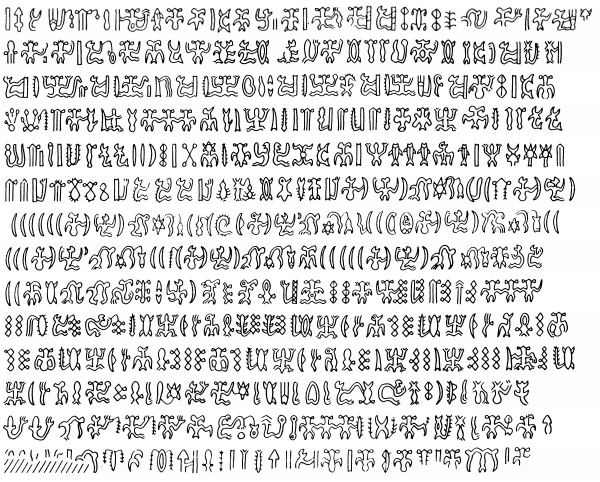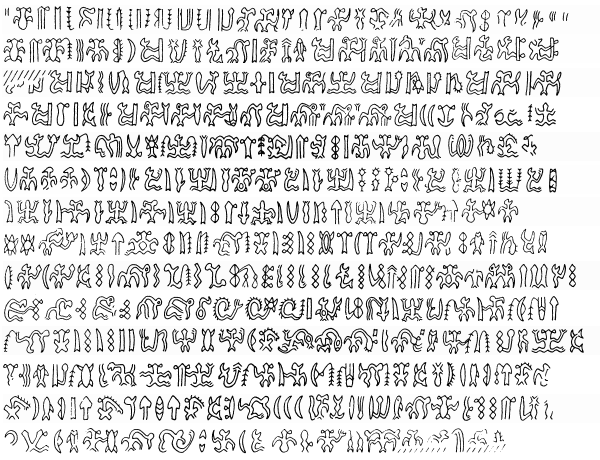
Rongorongo text C
Encyclopedia

Rongorongo
Rongorongo is a system of glyphs discovered in the 19th century on Easter Island that appears to be writing or proto-writing. It cannot be read despite numerous attempts at decipherment. Although some calendrical and what might prove to be genealogical information has been identified, not even...
corpus, also known as Mamari, is one of two dozen surviving rongorongo texts. It contains the Mamari Calendar.
Other names
C is the standard designation, from BarthelThomas Barthel
Thomas Sylvester Barthel was a German ethnologist and epigrapher who is best known for cataloguing the undeciphered rongorongo script of Easter Island....
(1958). Fischer (1997) refers to it as RR2.
Jaussen
Florentin-Étienne Jaussen
Monsignor Florentin-Étienne Jaussen was the first bishop of Tahiti and the man who brought the rongorongo script of Easter Island to the world's attention. In the 1860s Bishop Jaussen was responsible for ending the slave raids on Easter Island.Jaussen was born in Rocles, France...
called it Miro-Mimosa "Mimosa wood".
Location
General archives of the Padri dei Sacri CuoriCongregation of the Sacred Hearts of Jesus and Mary
The Congregation of the Sacred Hearts of Jesus and Mary and of the Perpetual Adoration of the Most Holy Sacrament of the Altar is a Roman Catholic religious order of brothers, priests, and nuns...
(SSCC), Casa Generalizia, Via Rivarone 85, I-00166 Rome, Italy.
Reproductions are located at the SSCC; Musée de l'Homme
Musée de l'Homme
The Musée de l'Homme was created in 1937 by Paul Rivet for the 1937 Exposition Internationale des Arts et Techniques dans la Vie Moderne. It is the descendant of the Musée d'Ethnographie du Trocadéro, founded in 1878...
, Paris; Museum of Mankind, London; Cinquantenaire
Cinquantenaire
Parc du Cinquantenaire or Jubelpark is a large public, urban park in the easternmost part of the European Quarter in Brussels, Belgium....
, Brussels; Museum für Völkerkunde, Berlin (2 copies); Institut für Völkerkunde, Tübingen (prior to 1989; on loan from the Linden-Museum); and the van Hoorebeeck Collection, Belgium.
Physical description
Excellent condition, with one hole at the top (verso). A rounded rectangular unfluted tablet, 29 × 19.5 × 2.5 cm, of Pacific rosewood (Orliac 2005). Fischer describes it as one of the loveliest tablets, and it may be the oldest.Provenance
One of Jaussen'sFlorentin-Étienne Jaussen
Monsignor Florentin-Étienne Jaussen was the first bishop of Tahiti and the man who brought the rongorongo script of Easter Island to the world's attention. In the 1860s Bishop Jaussen was responsible for ending the slave raids on Easter Island.Jaussen was born in Rocles, France...
tablets, Mamari was apparently collected on Easter Island
Easter Island
Easter Island is a Polynesian island in the southeastern Pacific Ocean, at the southeasternmost point of the Polynesian triangle. A special territory of Chile that was annexed in 1888, Easter Island is famous for its 887 extant monumental statues, called moai, created by the early Rapanui people...
by Father Gaspar Zumbohm in 1870 and sent to him in Tahiti. It was sent to the headquarters of the Congrégation des Sacrés-Coeurs et de l'Adoration (SSCC) in Paris, where it was deposited in the Missionary Museum, either by Jaussen in 1888 or by the French navy in 1892 after his death. In 1905 it was moved to the SSCC museum in Braine-le-Comte
Braine-le-Comte
Braine-le-Comte is a Walloon municipality located in the Belgian province of Hainaut.On January 1, 2006, Braine-le-Comte had a total population of 20,305...
, Belgium. In 1953 it followed the SSCC to Grottaferrata
Grottaferrata
Grottaferrata, Italy is a small town and comune in the province of Rome, situated on the lower slopes of the Alban Hills, 20 km south east of Rome. It is bounded by other communes, Frascati, Rocca di Papa, Marino, and Rome.-History:...
, near Rome, and in 1964 to Rome itself. In 1974 the SSCC moved to its permanent headquarters in Rome.
Fischer (1997) believes that Mamari and the Large Washington tablet
Rongorongo text S
Text S of the rongorongo corpus, the larger of two tablets in Washington and therefore also known as the Great or Large Washington tablet, is one of two dozen surviving rongorongo texts.-Other names:...
(S) are the only tablets with a documented premissionary provenance. He identifies it with a tablet called Kouhau ‘o te Ranga that had belonged to the ‘ariki
Ali'i
Alii is a word in the Polynesian language denoting chiefly status in ancient Hawaii and the Samoa Islands. A similar word with the same concept is found in other Polynesian societies. In the Cook Islands, an ariki is a high chief and the House of Ariki is a parliamentary house...
Nga‘ara, was stolen by his servant, who gave it to a friend, whose son sold it to Zumbohm.
Orliac (2005) calculated that in order for the trunk of the Portia tree the wood was cut from to be 20 cm in diameter, the tree must have been some 15 m tall. Easter Island had long been deforested of trees that size: Roggeveen in 1722, "described the island as destitute of large trees; González in 1770 wrote, Not a single tree is to be found capable of furnishing a plank so much as 15 cm in width; Forster in 1774 reported that there was not a tree upon the island which exceeded the height of 10 feet (Flenley and Bahn 1992:172).
Contents
Mamari is the only rongorongo text whose function has been ascertained. Two and a half of the fourteen lines on the recto have been shown to include calendrical information; Guy suggests possible phonetic readings of some of the glyphs in this section. Additional lines on both sides may also be calendrical.Katherine Routledge
Katherine Routledge
Katherine Maria Routledge, née Pease was a British archaeologist who initiated the first true survey of Easter Island....
was told that the Kouhau ‘o te Ranga tablet was one of a kind, a ranga tablet listing the names of enemy prisoners, and had the power to "give conquest in war" and enslave the conquered. However, the contents of Mamari are varied, with several passages paralleling inscriptions on other tablets, such as a repeated 380.1 glyph in lines Cv2-4, as well as the calendar.
Jaussen's informant Metoro Tau‘a Ure started his 'reading' of the tablet at the bottom of the verso, contradicting Pozdniakov's determination of the order. In addition, instead of continuing on the recto at the point where the verso left off, he restarted at the point diagonally opposite with a new subject.
Text
Fourteen lines of glyphs on each side, with ~ 1000 glyphs in total. A sequence of glyphs shared with tablets E, G, K, and N starts on Barthel's line Ca14 and continues onto Cb1, leading Pozdniakov to conclude that the sides Barthel listed as a and b are recto and verso, respectively.A distorted composite glyph has been squeezed in on the edge of the tablet, at the beginning of line Cr7, within the text of the calendar. This glyph is missing from Barthel's transcription and does not appear in any photograph. Fischer (1997) suggests it may be 631.78, but the repetition of the sequence in which it is found indicates it is an abbreviation of 670-8.78.711.
Barthel
-

- Recto (side a), as traced by Barthel. The lines have been rearranged to reflect English reading order: Cr1 at top, Cr14 at bottom.
-

- Verso (side b), as traced by Barthel: Cv1 at top, Cv14 at bottom.
Fischer

